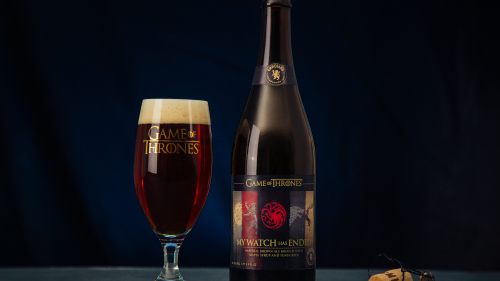Bending the Elbow: The Black Stuff
When I was a wee lad growing up in the suburbs of London I had a neighbour who was diagnosed with a blood condition. His doctor didn’t order him to take expensive pills and potions, oh no. He was prescribed two pints of Guinness a day. On the National Health Service. In other words, for free (because this was in that heady three year period in the 1960s when there were no prescription charges). If that’s not an argument for socialised medicine then I’m a monkey’s uncle, eek eek. These days the minimum prescription fee is more than the cost of a pint of Guinness. Progress? I don’t think so.
A that time Guinness could still get away with posters like the one on the left with its iconic “Guinness is good for you” slogan. No more, alas. Indeed, there are those who say that today’s brew is a pale imitation of the Guinness from bygone days before it was forced out of the tap with nitrogen dioxide instead of good old CO2, or even hand pulled from a barrel. In fact the method of delivery has changed far more than the recipe has since the days of Arthur Guinness.
There are all kinds of fantastical myths and stories surrounding Guinness, probably the most bizarre of which is that when the fermenters were cleaned out on one occasion many years ago, workers discovered either:
- Dozens of dead rats
- The body of one or more long-disappeared Guinness employees
- Some other equally gruesome (and unlikely) find
Having disposed of the corpses and, one hopes, thoroughly disinfected the vessels, production was resumed, but people complained that Guinness just didn’t taste the same so fresh meat was added as an adjunct.
This is, of course, hogwash, as is the idea that Arthur Guinness invented stout. Nor is it true that Guinness is black. Strictly speaking, the title of this piece should be The Really Really Really Dark Ruby Stuff.
It’s also been claimed that Guinness contains oysters. Not so, although ground oyster shells were once used as a fining to clarify the beer. Nowadays it’s done with isinglass – a form of collagen obtained from the swim bladders of fish, which is why Guinness isn’t vegan or, strictly speaking, vegetarian.
And then there’s the story that it takes precisely one minute and 59 seconds to pour the perfect pint of Guinness. The company imperative says that you pour roughly two thirds of a pint, let it stand until it goes completely black and then top it up by pushing the tap backwards instead of pulling it forwards, something which only nitro taps will do. When I worked at my first pub and was being shown the ropes I was told by my new boss, the landlord, that pushing the tap backwards puts less gas in the beer and creates the perfect head. Having taken apart and cleaned more than one Guinness tap in my time, I’ve found nothing about their innards to support this theory.
Now, while I love a pint of Guinness on a warm (or even a cold) day, and while I agree that the ‘surge’ of all those millions upon millions of bubbles rushing down the inside of the glass is impressive to watch, it’s my considered opinion that the two-part pour is, by a country mile, the biggest of the Guinness myths and is little more than a marketing ploy, but with a nugget of truth hidden deep inside.
You see, years ago when Guinness was still drawn from the wood with a beer engine and the muscles of the barmaid’s arm… well, let’s go back a bit further. Cask-conditioned beer is a delicate creature. Once the barrel is tapped it has, if kept under the right conditions, a life of only three or four days before the beer loses most of its carbonation and goes flat, and cask beer is already flatter than most kegged and carbonated beers. It can also go a little sour from contact with extraneous yeasts and bacteria in the air.
Before each barrel of Guinness left the brewery it was ‘krausened’ – fresh wort with a little yeast was added, which had the effect of carbonating the stout as the yeast produced CO2. When newly tapped this gave the Guinness of the time a creamy head and mouthfeel not dissimilar from the Guinness we’re familiar with today. As the barrel was drained the initial carbonation was lost so publicans would tap a new one and mix a small amount of Guinness from an old barrel with stout drawn from the fresh one. Not only was this a good way of using up beer that would otherwise be thrown away, it also gave Guinness that distinctive, slightly sour flavour, and gave rise to the idea of the two-part pour.
Which, in my opinion, is entirely unnecessary these days given that Guinness comes from a keg, and why I refuse to pour a Guinness this way.
There’s one more twist to this story though: today’s Guinness still has that slightly sour twang to it. How come? Well, at the brewery in Dublin there are, reputedly, huge oak vats that have been there for at least a century (some say since before Arthur Guinness himself was there) and which are infected – and I use the term in the nicest possible way – with some of the aforementioned wild yeasts and bacteria, including Brettanomyces, a type of yeast which gives sour Belgian ales their mouth-puckering qualities. When carefully controlled, Brettanomyces can enhance the flavour of beer or wine, adding complexity and giving a young wine some of the characteristics of a much older vintage.
Guinness will neither confirm nor deny that these fermenters exist and that a small quantity of this intentionally soured stout is pasteurised and added to each batch of Guinness before it’s kegged, but there is enough anecdotal evidence around to make it a near certainty, and homebrewers will often sour some of their beer when making a Guinness clone to get that twang of authenticity.
With the power of a multi-national corporation (Diageo) behind it, Draught Guinness is likely to remain the most widely drunk and well known stout for as far as the eye can see, even though are better stouts out there, some of which are even made by Guinness! Guinness Extra Stout, which I consider to be Guinness as it should be, has long been a favourite of mine, and Guinness Foreign Extra Stout (newly re-introduced to the American market about a month ago) is outstanding.
Just don’t put green food colouring in it on St. Patrick’s Day, okay?
Jim Hughes, Head Beer Nerd, Alamo South Lamar
“If I had all the money I’ve spent on drink… I’d spend it on drink.” ~ Sir Henry Rawlinson



